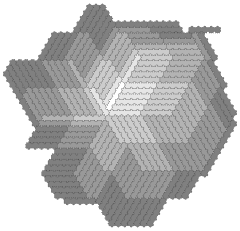
Casey Mann is an American mathematician, specializing in discrete and computational geometry, in particular tessellation and knot theory. He is Professor of Mathematics at University of Washington Bothell[2], and received the PhD at the University of Arkansas in 2001.
He is known for his 2015 discovery, with Jennifer McLoud-Mann and undergraduate student David Von Derau, of the 15th and last class of convex pentagons to tile the plane.[3][4][5][6][7]
Mann is also known for his work on Heesch's problem, to which he contributed a polygon with Heesch number 5. This problem is closely related to the einstein problem, of whether there exists a shape that can tessellate space, but only in a non-periodic way.[1][8]
Education and career
Mann received his B.S. in mathematics at East Central University in Ada, Oklahoma, and completed his Ph.D. in 2001 from the University of Arkansas. His dissertation in discrete geometry, supervised by Chaim Goodman-Strauss, was Heesch's Problem and Other Tiling Problems.[9]
Upon completing his doctorate, Mann joined the University of Texas at Tyler faculty for eleven years.[2]. He joined the faculty of University of Washington Bothell in 2013, where he is active in engaging undergraduate students in research.
References
- ^ a b Heesch Numbers and Tiling – Numberphile
- ^ a b Professor Casey Mann, University of Washington Bothell
- ^ Mulcahy, Colm (October 28, 2015), Martin Gardner at 101 ("It's as not-so-easy as 3, 4, 5"), Scientific American
- ^ Siegel, Robert; Rehmeyer, Julie (August 14, 2015), Scientists Discover 15th Convex Pentagon Able To Tile A Plane, NPR
- ^ "Attack on the pentagon results in discovery of new mathematical tile", Mathematics: Alex Bellos's Adventures in Numberland, The Guardian, August 11, 2015
- ^ Freeman, David (August 19, 2015), "Historic 'Tile' Discovery Gives Math World A Big Jolt: It's the first such find in 30 years", Huffington Post
- ^ Honner, Patrick (December 11, 2017), "The (Math) Problem With Pentagons", Quanta Magazine
- ^ Mann, Casey (2004), "Heesch's tiling problem", The American Mathematical Monthly, 111 (6): 509–517, doi:10.1080/00029890.2004.11920105, S2CID 6900530
- ^ Casey Mann at the Mathematics Genealogy Project
External links
